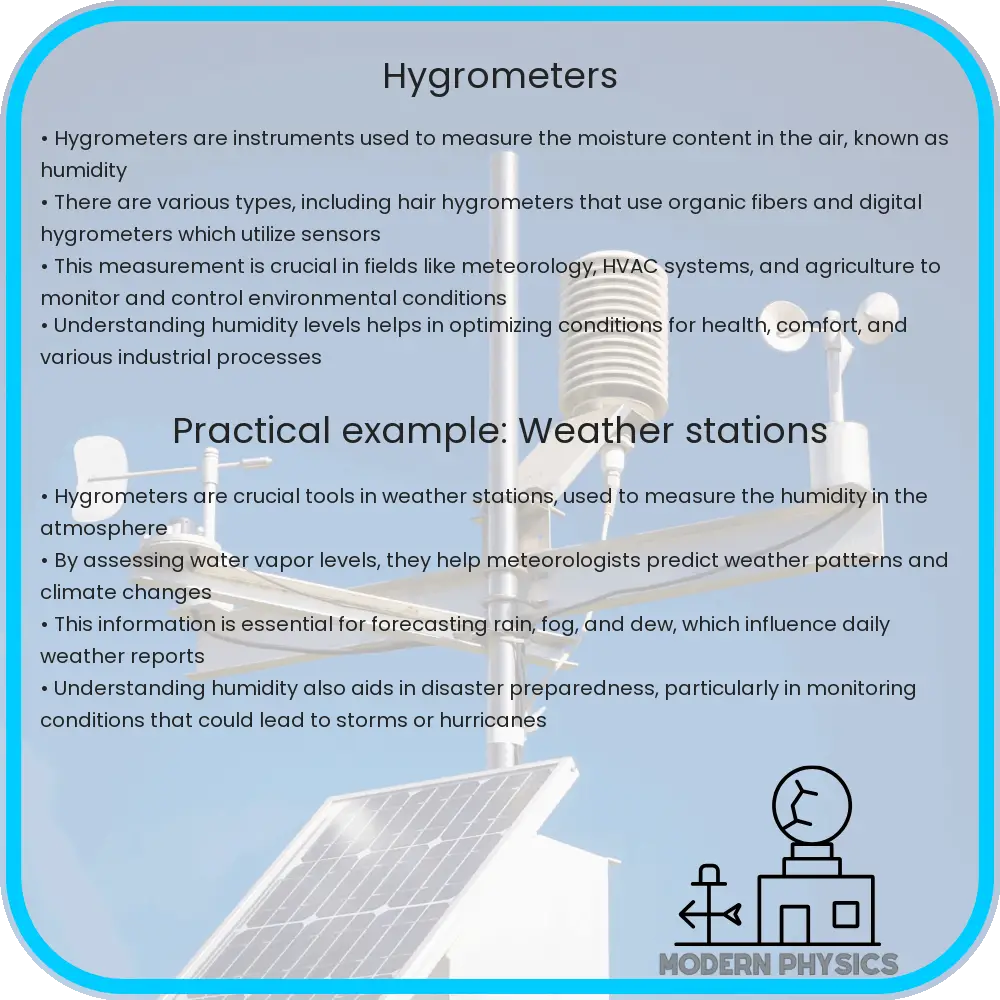Learn about hygrometers, sensitive tools essential for measuring humidity and moisture content in various environments.

Understanding Hygrometers: Instruments of Precision and Reliability
Hygrometers are essential tools used to measure the moisture content in the air, commonly known as humidity. These instruments play a crucial role in meteorology, agriculture, industrial processes, and even in the maintenance of comfortable environments within homes and workplaces. This article delves into the workings of hygrometers, exploring their types, precision, reliability, and how they offer valuable insights into weather conditions.
Types of Hygrometers and Their Working Principles
There are several types of hygrometers, each employing different methods to measure humidity. Understanding these various types can help us appreciate the innovation behind each methodology and the specific contexts in which they excel.
- Psychrometers: This type leverages the cooling effect of evaporation. A psychrometer consists of two thermometers, one dry and one covered in a wet cloth (wet-bulb). The difference in readings between these two thermometers, due to evaporation cooling the wet-bulb, is used to calculate humidity.
- Capacitive Hygrometers: These devices measure humidity through changes in capacitance caused by the absorption or desorption of moisture on a hygroscopic material, which alters the electrical characteristics of the capacitor.
- Resistive Hygrometers: Resistive hygrometers determine humidity by detecting changes in electrical resistance of materials that vary with moisture content.
- Thermal Conductivity Hygrometers: They measure humidity based on the changes in thermal conductivity of air as its moisture content varies.
Each type of hygrometer has its own unique advantages and is selected based on the specific requirements of the task at hand, such as the range of humidity levels it needs to measure, the environment in which it is used, and the required precision and reliability.
Precision and Reliability in Hygrometers
The precision and reliability of a hygrometer are influenced by various factors, which include the design and quality of the instrument, as well as the environmental conditions under which it operates. For instance, capacitive hygrometers are highly valued for their sensitivity and accuracy in environments with rapid humidity changes. Conversely, psychrometers, while generally less expensive, require careful calibration and maintenance to provide reliable readings. Factors such as temperature, air contaminants, and mechanical alterations can impact the performance and accuracy of hygrometers.
Manufacturers often indicate the expected error margins and conditions for optimal operation in the specifications of the hygrometers. End-users must consider these details to choose the right hygrometer that matches their accuracy requirements and expected environmental conditions.
Insights Gained from Hygrometers in Weather Prediction
Hygrometers are integral to the field of meteorology. Humidity levels are a critical component in weather systems and can influence various atmospheric conditions. For instance, high humidity can indicate the potential for rain or fog, while sudden changes in humidity can signal an approaching weather front. Meteorologists use data collected from hygrometers to aid in forecasting weather patterns, preparing for weather-related disasters, and understanding climate change implications.
The role of hygrometers in weather prediction extends to everyday applications such as determining the “feel” of the air, which combines temperature and humidity to calculate the heat index or “real feel” temperature. This information proves vital not only for general comfort but also for health and safety in extreme climatic conditions.
Practical Applications Beyond Meteorology
Aside from weather prediction, hygrometers find utility in numerous other sectors. In agriculture, farmers utilize hygrometers to determine the best planting times and manage irrigation more effectively by monitoring humidity levels that affect crop growth. Hygrometers are also critical in museums and archival storage, where maintaining specific humidity levels prevents deterioration of precious artifacts and documents.
In the industrial sector, hygrometers monitor and control humidity in manufacturing environments, crucial for producing electronics, pharmaceuticals, and textiles. High precision hygrometers ensure product quality and safety, underscoring the importance of accurate humidity measurement in industrial processes.
Maintaining and Calibrating Hygrometers
To maintain the accuracy of hygrometers, regular calibration is essential. Calibration involves comparing the hygrometer’s readings with a known standard, and making adjustments if discrepancies are found. This practice is particularly crucial for digital hygrometers, which may drift over time due to electronic component aging.
Cleanliness also plays a significant role in the performance of a hygrometer. Particles like dust and smoke can coat sensor surfaces and interfere with their ability to detect humidity accurately. Hence, routine cleaning and careful handling are recommended to extend the lifespan and reliability of these instruments.
Conclusion
Understanding and utilizing hygrometers is crucial across various fields to ensure efficient operation and maintain safety and comfort. From meteorology to agriculture, and industrial processes to daily home use, these instruments provide critical data that helps in making informed decisions. Their diverse applications illustrate their significance beyond just measuring humidity—they are indispensable in advancing technology, enhancing environmental awareness, and elevating the quality of life.
By appreciating different types of hygrometers and their respective merits, users can select the appropriate tools for their specific needs. Keeping these delicate instruments calibrated and clean further ensures their precision and reliability. As we continue to explore the intricacies of our environment, hygrometers stand out as valuable allies in our quest to understand and adapt to our ever-changing world.
